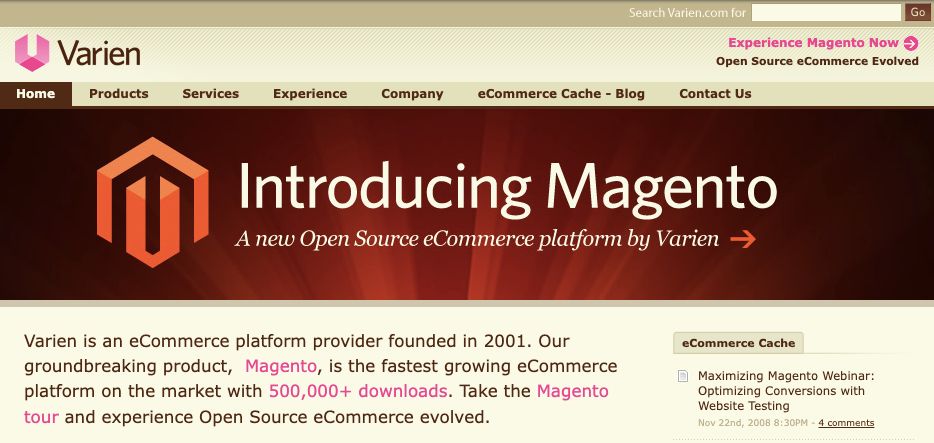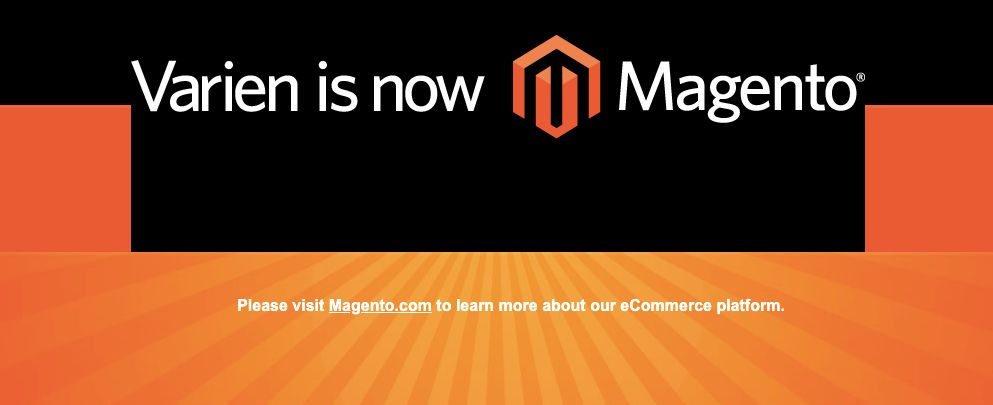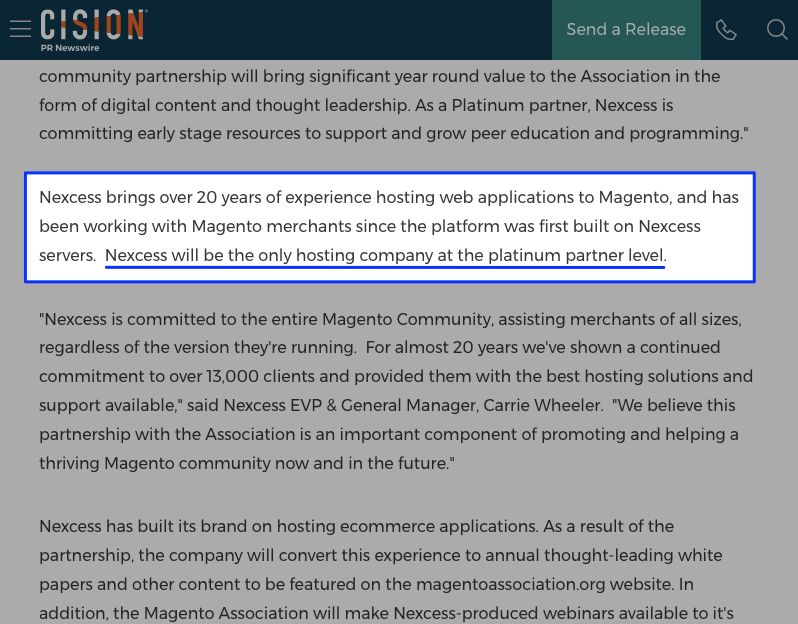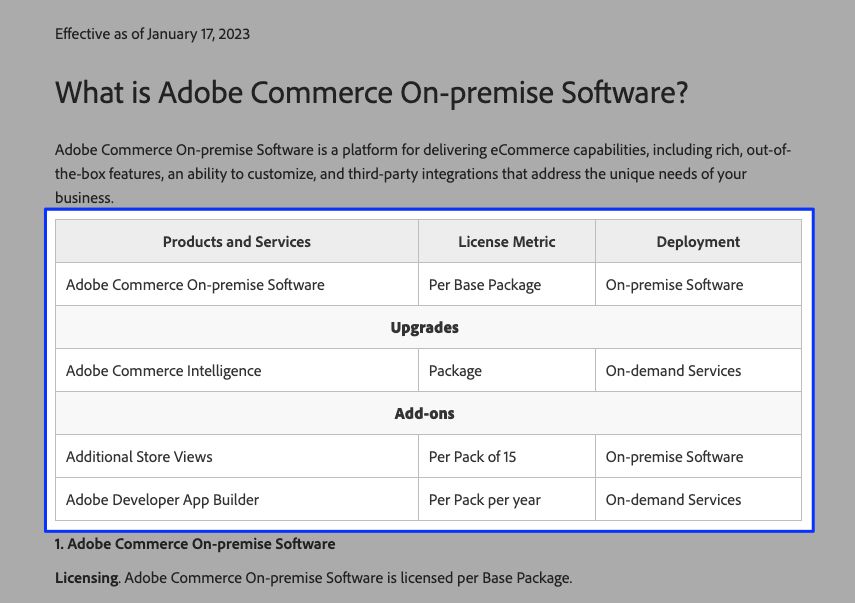Magento is a direct response to the needs of ambitious merchants whose visions outpaced the capabilities of a pioneer ecommerce solution, osCommerce. Unbeknownst to Magento’s founders, their fledgling open-source software would become a global ecommerce powerhouse.
Fast-forward to 11 years after its release: It sold in a landmark deal with a Fortune 500 company for $1.68 billion.
This Magento history rundown will lead you through the platform’s most significant milestones. You’ll discover how it progressed through humble beginnings, Magento Enterprise on Nexcess servers, attracting an exclusive PayPal partnership, and closing its eventual eBay buyout.
As you delve deeper into Magento’s fascinating journey, you’ll see why it remains a game-changer in the digital marketplace.
You’ll also explore how Magento became a market leader in enterprise ecommerce and why Nexcess became its only platinum hosting partner.
In summary, here’s what you’ll learn:
- A brief history of Magento
- Who owns Magento?
- Magento’s editions, versions, and changes
- Magento hosting and support from Nexcess
- How Nexcess supports businesses that use Magento
- Final thoughts: Magento history — from early versions to enterprise commerce
A brief history of Magento
Varien Inc., which would eventually become Magento, started in 2001 as an ecommerce development and consulting firm in Los Angeles, California.
The people behind Varien would go on to shape Magento’s history as we know it.
Magento’s founders and their journey to open-source ecommerce
Roy Rubin and Yoav Kutner launched Magento as an open-source ecommerce platform in 2007. The PHP-based software quickly gained popularity for its scalability, flexibility, and extensive feature set. Here’s how it came to be.
Roy founded Varien as a UCLA student. Yoav joined in 2004, serving as the CTO and co-founder of the company until April 2012.
In a 2009 Mixergy interview, Roy said their biggest breakthrough came in 2003 or 2004 when they discovered osCommerce, an open-source platform with a substantial user base.
As part of running their ecommerce consultancy, Roy and Yoav built websites using a forked version of osCommerce.
Roy noticed osCommerce had limited service providers. So he ran Google ads to attract osCommerce clients.
The campaign resulted in an overwhelming influx of clients overnight. This breakthrough grew the business rapidly and helped its founders build their expertise around osCommerce clients.
According to Roy, a fifty-cent AdWord campaign secured their biggest client. He attributes the financing and eventual success of Magento to this client.
In a 2016 interview on Magenticians, Yoav said they intended to build Magento solely for their customers and projects. However, they eventually decided to offer Magento as open-source software, which was initially tough to monetize but paid off in the long run.
Magento’s strategic growth
In Yoav’s interview with Magenticians, he said, “We couldn’t have imagined it would grow and become one of the leading ecommerce products on the market.”
However, looking at the history of Magento, you’ll discover that its founders worked hard and took proactive steps that set it up for success.
For example, in the Mixergy interview, Roy said they established Varien as a market leader through blogging. They worked extremely hard to publish posts daily, meaning people consistently saw Varien in their RSS feeds and remembered the brand.
Roy added that their posts hardly promoted the company. Instead, they established industry authority by sharing helpful content about ecommerce best practices they found while working, and the market trends they saw happening.
He also said they implemented feedback from community members, working harder for longer hours with every Magento update.
The results were outstanding. Between Aug. 31, 2007 (when Magento 1.0 launched in beta) and Jan. 26, 2010, Magento surpassed 1.5 million downloads.

According to Crunchbase data, Magento’s success attracted $22 million in investment funding from eBay in March 2010. That led to PayPal (an eBay subsidiary at the time) publishing a press release that it would integrate with Magento to offer merchants its payment solutions.
Following Magento’s rapid success, Yoav recounted in an interview: “My most favorable memory of my time there was presenting the Magento platform at a talk in front of thousands of eBay partner developers at their developer’s conference, Innovate.”
On March 15, 2020, TechCrunch reported that Magento was powering 60,000 active merchants who had completed over $15 billion in transactions.
Magento history: Transitioning from Varien
Varien introduced Magento in early 2007, launched the beta version in August of that year, and opened it to general users on March 31, 2008.
However, Magento remained a product within Varien for the next two years.

By November 2008, Magento had already exceeded 500,000 downloads, making it one of the fastest-growing ecommerce platforms on the market.

In March 2010, Magento’s success led to Varien forming Magento Inc., rebranding the business as an ecommerce software company. At this point, it stopped offering Magento development and ecommerce consultancy services.

According to Yoav, Magento stood out by supplying small and medium-sized businesses with the tools to compete meaningfully against bigger, wealthier companies.
The history of Magento’s relationship with Nexcess
Nexcess has supported Magento since it was called Varien. Magento Enterprise Edition was launched in April 2009 — by May 12, 2009, Nexcess announced its Magento web hosting service.
Through that partnership, Nexcess proved that developers could host Magento on server clusters, which some people had yet to believe.
Magento and Nexcess have continued strengthening ties for over two decades, transcending Magento’s history with eBay and Adobe. That’s why on Oct. 22, 2019, Nexcess became Magento’s only platinum hosting partner.

Who owns Magento?
Throughout the history of Magento, the company has changed ownership a couple of times — from Varien to eBay to Permira. Currently, Adobe owns Magento.
Varien owned 100% of Magento until it received its first funding.
In March 2010, roughly 31 months after Magento’s launch, eBay acquired a 49 percent stake in the company for $90 million. A year later, the Fortune 500 company paid another $90 million to buy out Magento.
On Nov. 3, 2015, following eBay’s split from PayPal, Magento came under new ownership: Permira, as an independent company. This new owner eventually sold Magento to Adobe in 2018 for $1.68 billion.
In 2021, Adobe unified its experience-driven commerce solutions with the advanced capabilities of Magento Commerce.
Magento’s editions, versions, and changes
In 2017, Permira rebranded Magento Community Edition (Magento CE) to Magento Open Source. Additionally, it rebranded Magento Enterprise Edition (Magento EE) to Magento Commerce — which Adobe later rebranded to Adobe Commerce.
But after acquiring Magento, Adobe introduced Adobe Commerce Cloud, at the 2019 Adobe Summit, as an umbrella term to cover its suite of ecommerce products. This supercategory includes Adobe Commerce, Adobe Experience Manager, Analytics, and Target.
Today, Magento offers two main editions: Adobe Commerce and Magento Open Source.
Adobe Commerce is further grouped into two options: Magento Commerce Cloud and Magento Commerce On-Premise.
The Cloud edition allows you to host your store on Adobe’s cloud infrastructure. Alternatively, the On-Premise edition lets you host on a private server.
Let’s look at these Magento versions and editions more closely.
Versions of Magento
Varien released the first official version of Magento 1.0 in 2008. Over the next six years, Magento released nine more versions, running from Magento 1.0 to 1.9. Magento Enterprise Edition has versions ranging from 1.6 to 1.14.
On Nov. 17, 2015, the company launched Magento 2.0 under the ownership of Permira.
Roy and Yoav introduced Magento 2 to resolve several critical issues in Magento 1. Specifically, they wanted to enhance performance, replace frontend reliance on the Prototype JavaScript library, and refine certain EAV implementations within Magento.
Magento 2 editions have nine release versions, ranging from 2.0 to 2.4.7, with over 90 patch versions.
Magento Open Source and its extensions
This edition was known as Magento Community Edition until Magento’s rebranding in 2007. Magento Open Source is free and suitable for businesses that want independent data management and hosting.
Magento boasts an active community of developers who create extensions for the platform. By installing these extensions from the Magento marketplace, you can replicate out-of-the-box B2B features of Adobe Commerce.
For instance: B2B self-service, payment processing, shipping options, shared catalogs, and user roles are all native to Adobe Commerce. But extensions let you replicate these features in Magento Open Source.
With Open Source, you’ll need to set up your own server, which can be done by choosing an open-source hosting plan.
Magento Commerce On-premise
In 2007, Magento Enterprise On-premise Edition was rebranded to Magento Commerce On-premise. Following Adobe’s rebranding efforts, it’s now called Adobe Commerce On-premise.

This self-hosted platform lets ecommerce businesses control all aspects of their online stores. You can access advanced features to manage your product catalog, sales, SEO, marketing, customer service, and reporting.
Magento Commerce Cloud or Adobe Commerce
Adobe Commerce is a premium Magento ecommerce platform with advanced features, built-in cloud hosting, and enterprise-level support. It’s essentially everything you’ll get with the on-premise solution but hosted on Adobe Cloud infrastructure.
Now you’re up to date with the history of Magento. Here’s how Nexcess helps you thrive on the platform today.
Magento hosting and support from Nexcess
Business owners can host multiple Magento enterprise websites on Nexcess server clusters without sacrificing speed or power.
Each Nexcess hosting plan ensures seamless online store operation by providing these essential features:
- SSL certification.
- A high-performance Magento stack.
- RAM burst capacity.
- PCI compliance.
- SSH and SFTP access.
Nexcess hosting plans also include advanced support for both Magento 1 and Magento 2. With PHP workers, round-the-clock access to Magento experts, and multi-store support, your ecommerce website will get the performance boost and support it needs to thrive.
With Magento 2.4 and higher, you get Elasticsearch, which provides swift, efficient, and powerful search features for your store. Moreover, Nexcess enterprise plans support VCPU capabilities and enterprise-grade DevOps.
Nexcess lends its expertise to business owners migrating their websites from other platforms to Magento, ensuring a seamless transition with minimal downtime.
How Nexcess supports businesses that use Magento
In addition to its hardware and software support, Nexcess offers high-level security features to protect your server architecture from cyberattacks. Beyond typical hosting responsibilities, Nexcess also tackles crucial maintenance tasks such as applying security patches and analyzing logs.
Nexcess engineers can help you resolve conflicts with third-party modules, extensions, and themes that disrupt website functionality on your ecommerce store.
Final thoughts: Magento history — from early versions to enterprise ecommerce
Magento has come a long way since its launch in 2007. Despite early skepticism about its scalability, Nexcess saw Magento’s potential and became the first to successfully configure a server environment that enterprise users grow with.
A decade later, Magento is at the heart of Adobe’s ecommerce solutions, making it a household name among top ecommerce brands.
At Nexcess, we provide PCI-compliant enterprise Magento hosting, 24/7/365 expert support, unlimited migrations, and full-stack activation to Magento users.
To ensure 100 percent uptime and fast-loading pages even during traffic spikes, try Nexcess enterprise Magento hosting. Check out our plans to get started today.

